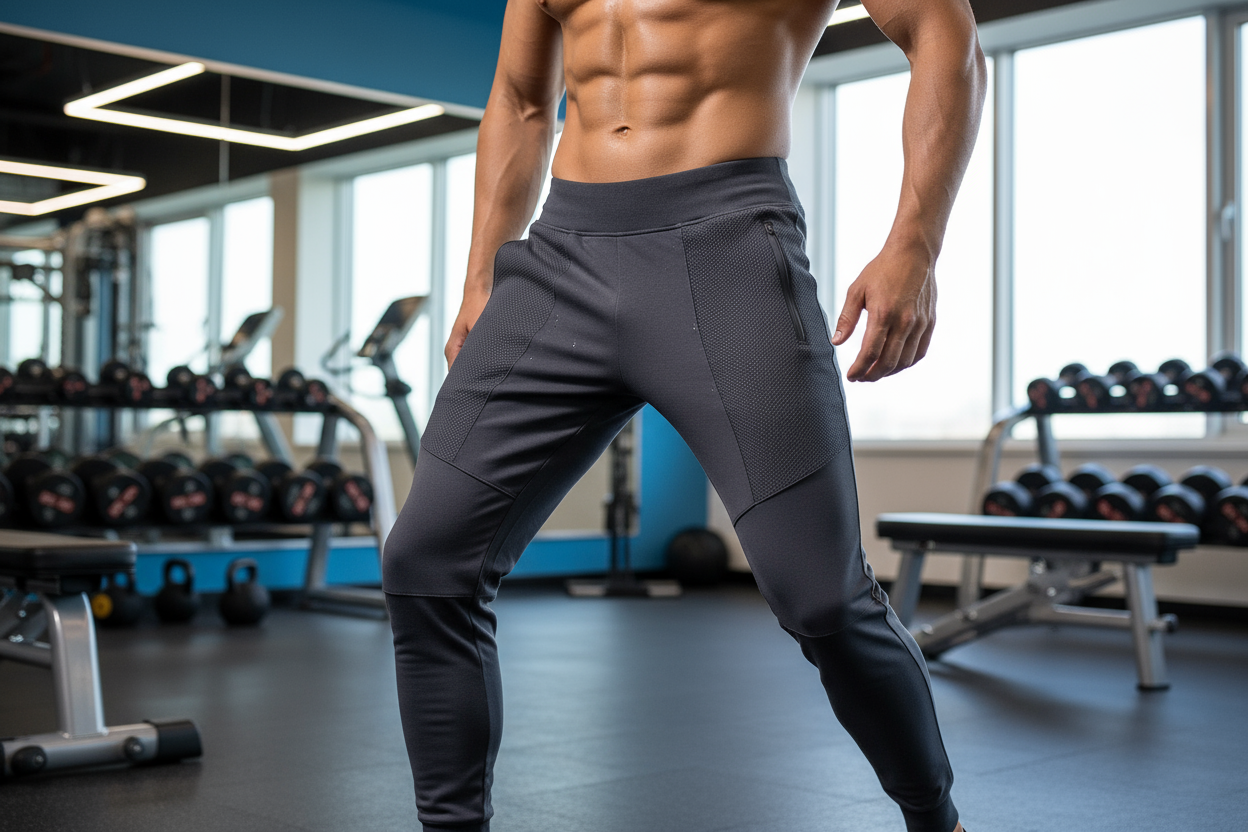Compression clothingal so known as compression wear refers to tight-fitting garments that apply pressure to your muscles and limbs. With garments like leggings, tops, sleeves, and socks, compression wear has become a staple in both athletic performance and recovery. At Myovv, our compression wear collection is designed to combine functionality, comfort, and style, so you can feel supported whether you're training hard, recovering, or just going about your daily routine.
We’ll also back up claims with the latest research so you (and your customers) can understand the real value of compression gear.
What Is Compression Clothing?
Compression clothing consists of garments made from elastic, tightly woven fabrics that exert gradual pressure on parts of the body usually on muscles or limbs. This isn’t just tight workout gear; it's engineered to provide graduated compression, meaning the pressure is often higher at the extremities (like ankles or wrists) and slightly less as you move up.

Compression wear comes in many forms:
- Compression tights or leggings for legs, thighs, calves
- Compression shorts for lower-body support
- Compression tops for the torso, arms, or full body
- Compression sleeves for arms or calves
- Compression socks or stockings for lower legs, ankles
These garments are commonly used in sports, recovery, and even medical settings because of their ability to improve circulation and support muscles.
The Science Behind Compression: How It Actually Works
To understand why compression clothing is effective, it's helpful to look at the key mechanisms at work:
-
Improved Venous Return
Compression applies external pressure to veins, helping blood flow back more efficiently toward the heart. This reduces pooling of blood in the limbs and enhances circulation. Studies have shown that compression garments can improve peripheral blood flow, especially venous return. -
Reduced Muscle Oscillation (Vibration)
When muscles contract and bounce during activity, micro-trauma can occur. Compression stabilizes the muscles, reducing oscillation, which can improve performance and reduce fatigue. -
Faster Metabolite Clearance
By improving blood flow, compression garments help clear metabolic waste (like lactic acid) more quickly from muscles, which supports recovery. -
Reduced Muscle Damage & Soreness
Meta-analyses of post-exercise recovery show that compression wear helps decrease delayed onset muscle soreness (DOMS), as well as markers of muscle damage. -
Enhanced Proprioception
The snug pressure of compression garments improves the body's awareness of limb position, which can lead to better coordination and stability. -
Thermal and Comfort Effects
Compression clothes can also influence skin temperature, sweat, and how you feel during and after exercise.
Benefits of Compression Clothing: What Research Says
Here are the main benefits of compression clothing, backed by scientific research:

1. Improved Recovery
One of the strongest areas where compression clothing shines is in post-exercise recovery. A meta-analysis of 23 studies found that compression garments modestly but significantly improve recovery of strength, power, and endurance after exercise.
Another systematic review and meta-analysis found that compression wear helps reduce the decline in muscle strength and power following fatiguing exercise.
Compression garments also help lower the severity of muscle soreness (DOMS) and reduce biomarkers of muscle damage.
Bottom line: Compression wear can be a useful tool in your recovery toolkit, helping you bounce back faster and feel less sore.
2. Enhanced Blood Flow
Research shows that wearing compression garments increases peripheral blood flow, particularly in the venous system.
A specific study on basketball players demonstrated that compression tights significantly increased markers of venous return, muscle blood flow, and even muscle oxygenation at rest, compared to no compression.
This improved circulation is central to many of the recovery and performance benefits of compression wear.
3. Performance Support
Though compression clothing is more often linked to recovery, there is also evidence that it provides small but meaningful performance gains. A meta-analysis of compression sportswear showed improvements in speed, endurance, and motor performance.
These effects may not be dramatic, but they can matter, especially in competitive or high effort settings.
4. Muscle Strength and Fatigue Mitigation
Compression helps mitigate the decline in muscle strength and power after fatigue inducing exercise.
Interestingly, the benefit varies by rest interval: for lower-body garments, strength recovery was most significant in rest periods of 1–24 hours and over 72 hours.
This suggests that timing and how long you keep on compression garments can influence how effective they are for recovery.

5. Limitations & Nuanced Findings
Compression isn’t a magic fix, and scientists are cautious about overstating benefits:
- One randomized controlled trial found that compression tights did not significantly affect markers of muscle protein synthesis, blood flow, or recovery measures in the 24 hours after resistance exercise.
- According to research from Mid Sweden University, most studies do not show meaningful changes in oxygen uptake (VO₂) or heart rate during exercise when wearing compression garments.
- Effectiveness can depend on things like compression pressure, how tight the garment is, and how long it's worn.
Who Should Use Compression Clothing?
Compression wear is not just for elite athletes. Here are groups that can benefit:

Athletes & Fitness Enthusiasts
· Runners, cyclists, weightlifters, and team sport players can use compression for both performance and recovery.
People Focused on Recovery
· If you train often or do high-intensity workouts, wearing compression in the hours after exercise can help reduce soreness and speed up recovery.
Desk Workers / People Who Sit a Lot
· Compression socks or leggings can support circulation, reduce swelling, and prevent fluid from pooling in your legs.
Frequent Travelers
· For long flights or road trips, compression garments help maintain blood flow and reduce fatigue.
People with Mild Circulatory Issues or Swelling
· While compression gear is not a substitute for medical therapy, moderate, non-medical compression wear may help with mild swelling or fluid retention (always check with a doctor).
How to Choose the Right Compression Wear
Here’s a practical guide to picking the right compression clothing from a collection like Myovv’s:

Compression Level / Pressure
· Measured in mmHg (millimeters of mercury).
· Moderate compression (e.g., 15–20 mmHg or similar) is often ideal for athletic or recovery use.
· Very high compression (medical grade) is not typically needed in everyday fitness; use only if prescribed.
Fit & Sizing
· Compression works only if the garment fits properly not too loose, not painfully tight.
· Use size charts and measure your limbs (calf, thigh, arm) for accurate sizing.
Material & Fabric
· Look for breathable, moisture-wicking fabrics (nylon, spandex, elastane).
· Durable fabric matters: good compression wear retains elasticity even after many washes.
Garment Type Based on Purpose
· For training: Consider shorts, tights, or sleeves.
· For post-workout recovery: Full leggings or longer-wear designs can help.
· For everyday wear: Compression socks or lighter tops are ideal.
Design & Comfort
· Seamless or flat seam designs reduce chafing.
· Choose garments with good stretch and recovery (i.e., they don’t sag after a few usages).
Usage Duration
· Determine how long you plan to wear: during workouts, for several hours post-exercise, during travel, etc.
· Some garments are more comfortable for extended wear than others.
How to Use Compression Clothing Effectively
Here are tips to maximize the benefits of your compression gear:

- During Training: Wear compression garments in workouts where you want extra muscle stability or minor performance support.
- Post-Workout Recovery: Put on compression wear 30 minutes to a few hours after training; studies show recovery benefits in that window.
- Consistent Use: For long sessions (like flights or long workdays), consider compression socks or leggings to support circulation.
- Care & Maintenance: Wash in cold water, avoid fabric softeners, and air-dry to preserve elasticity.
- Rotate: If you train often, rotate between two or more compression garments so each can recover its stretch.
- Monitor Fit Over Time: Elasticity fades; if a garment starts feeling too loose or doesn’t compress as before, consider replacing it.
Precautions & Possible Downsides
While compression wear is generally safe, be aware of:
- Too Tight: If the garment is overly tight, it can restrict circulation or cause discomfort.
- Skin Irritation: Tight seams or non-breathable fabrics may irritate the skin.
- Medical Conditions: People with circulatory or vascular issues (e.g., deep vein thrombosis) should consult a doctor before using compression garments.
- Incorrect Use: Using compression as a substitute for sleep, rest, nutrition, or proper recovery strategies is a mistake. It should complement, not replace, other recovery methods.
Why Choose Myovv Compression Wear
At Myovv, our compression wear collection is thoughtfully designed with these advantages:
- High Quality Fabrics: We use premium stretch-material blends that are breathable and durable.
- Optimal Compression: Our garments are engineered to deliver the right pressure distribution supportive yet comfortable.
- Modern Design: Sleek and functional styles that don’t look purely clinical; ideal for gym, recovery, or even casual wear.
- Versatility: From full-leg compression leggings to sleeves and socks, you’ll find options for training, recovery, and daily use.
- Longevity: Our compression wear is built to keep its tension and support through repeated use and laundering.
Real World Use Cases for Compression Clothing
Here are a few scenarios where Myovv compression wear can make a real difference:
- Weight Training: Put on compression tights or shorts during heavy lifting to stabilize muscles and reduce micro-vibrations.
- Cardio / HIIT: Use compression wear to feel more supported, especially during high impact movements.
- Post Workout: After a hard session, switch into compression gear to help flush out metabolic waste and reduce soreness.
- Long Flight or Travel: Wear compression socks or leggings to support circulation and reduce swelling in your legs.
- Everyday Movement: Even if you don’t exercise, compression wear can help if you're sitting or standing for long hours.
Summary: Why Compression Clothing Is Worth It
- Compression clothing is more than just tight gym wear it's a performance and recovery tool backed by science.
- Research supports its benefits for blood flow, muscle recovery, reduced soreness, and strength maintenance.
- While not a cure-all, compression wear is a smart addition to your fitness routine when used correctly.
- Myovv’s compression wear collection provides high quality, thoughtfully designed garments to help you train, recover, and feel supported.
Research References
Here are key research articles and reviews to back up the points in this article:
- Compression Sportswear Improves Speed, Endurance, and Functional Motor Performances: A Meta-Analysis. MDPI Applied Sciences.
- Compression Garments and Recovery from Exercise: A Meta-Analysis. PubMed.
- Effects of Compression Garments on Muscle Strength and Power Recovery Post-Exercise: A Systematic Review and Meta-Analysis. PubMed / World of Science.
- Compression Garments and Recovery from Exercise-Induced Muscle Damage: A Meta-Analysis. BMJ (via PubMed).
- The Acute Effects of Compression Garments on Muscle Protein Synthesis, Blood Flow, Performance, and Perceived Recovery After Resistance Exercise. PubMed.
- Do Sports Compression Garments Alter Measures of Peripheral Blood Flow? A Systematic Review with Meta-Analysis. PubMed.
- Sports Compression Garments Improve Resting Markers of Venous Return and Muscle Blood Flow in Male Basketball Players. PubMed.
- The Effect of Compression Garments on Biomechanical and Physiological Factors. MDPI.
- Wearing Compression Garments During Exercise and in Recovery. Mid Sweden University (research summary).




Leave a comment
This site is protected by hCaptcha and the hCaptcha Privacy Policy and Terms of Service apply.